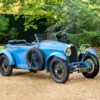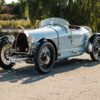In 1934, the Bugatti Type 57 roared onto the scene, marking a turning point under Jean Bugatti’s leadership. It was the first all-new design under Jean Bugatti’s leadership, showcasing his innovative spirit.
The car boasted a powerful eight-cylinder engine with a unique camshaft design and a first-for-Bugatti transmission fixed directly to the engine. Jean even experimented with an independent front suspension, but ultimately retained the traditional Bugatti leaf spring setup.
The Type 57’s success wasn’t just about mechanics. Jean’s true genius shone through in the car’s breathtaking bodywork. He sculpted elegant coupes, convertibles, and sedans (Atalante, Ventoux, Stelvio, and Galibier) that rivaled the finest coachwork in Europe.
Despite financial struggles, Bugatti persevered, refining the Type 57 with a stiffer frame, a rubber-mounted engine, and a supercharged version (Type 57C) offering a thrilling 160 horsepower. Finally, in 1938, Bugatti embraced practicality, adopting hydraulic brakes and more affordable wheels, showcasing their ability to adapt while staying true to their heritage.
Photos by Darin Schnabel courtesy of RM Sotheby’s

















